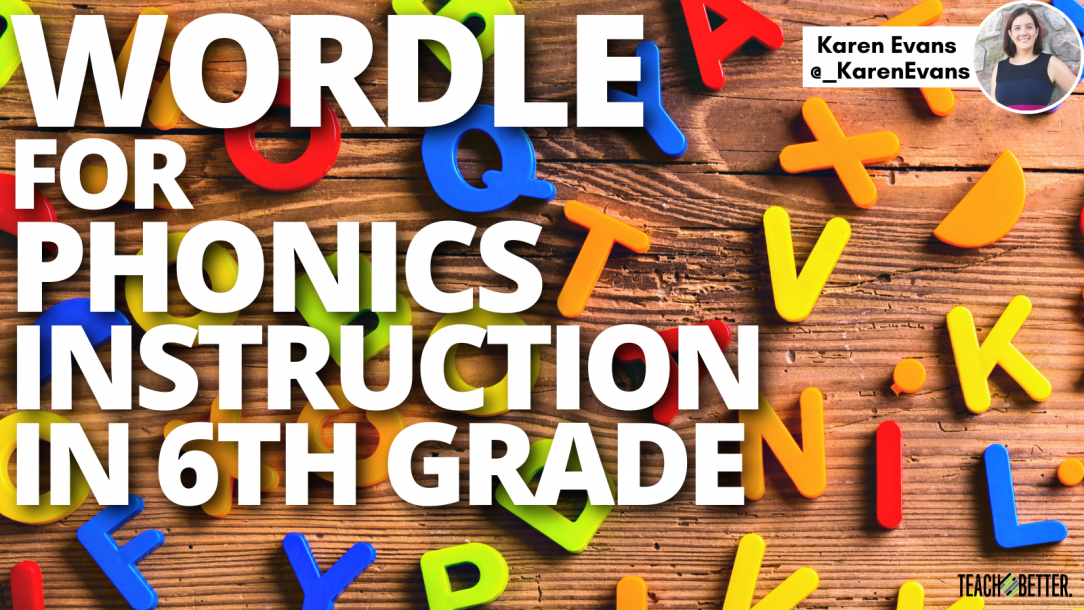TL;DR:
- Wordle is a word game that quickly gained popularity.
- Playing Wordle as bell work is a quick and engaging way to start your class period.
- Wordle allows the opportunity to learn and practice phonics skills in a more natural way—through a game.
- Playing games is a natural way to boost student confidence and for them to see the growth they’re making.
Wordle
By now, almost everyone has heard of Wordle. In fact, I saw a meme wondering if your pre-pandemic self would get the statement that Wordle is the sourdough of 2022.
For those of you unfamiliar with the word game, one must type a five-letter word into Wordle’s website. Once entered, the site will tell you which letters are in the word but in the wrong spot, which letters are in the correct spot, and which letters aren’t in the word at all. You have six tries using these clues to guess the word of the day. It’s super fun and people are in love with it—for good reason.
Because I’m a teacher who brings my full self to class, when I became obsessed with Wordle, I definitely told my students about it. Through that conversation, I decided to play it as a bell ringer activity daily when my 6th-grade special education students came in for reading resource time.
Wordle is a great way to allow exploration and self-discovery paired with direct instruction. Share on XBell Work
My reading resource class is immediately after lunch, and Wordle is the perfect way to get kids to come in quickly and give them something purposeful to do until everyone trickles in. The students experienced a learning curve initially. But now, they are fully engaged and competitive, thus reducing the transition time it takes them to arrive at class each day. They are eager to start working, and it gets their brains fired up.
Phonics Skills
The first time I played Wordle, I saw the potential for natural phonics practice. Many of my students struggle with reading and demonstrate difficulty with phonemic awareness and phonics skills. That said, they’re also in 6th grade. How can I teach these skills while maintaining their dignity as teenagers?
Wordle is a great way to allow exploration and self-discovery paired with direct instruction. After a few minutes of play, I ask them what patterns they noticed. This discussion has allowed me the opportunity to discuss blends and digraphs comparing them to trail mix and milkshakes respectively. Blends are like trail mix because you can still hear the separate sounds, just like you can make trail mix and then pick out the M&Ms—which clearly are the best part. Digraphs are two letters coming together to make a completely different sound like the ingredients of a milkshake coming together in a way that doesn’t exactly allow you to separate the ingredients again. Discussions have also brought us to vowel teams, silent e, bonus letters, and all the other skills often included in phonics lessons.
While teaching reading is something I love and something that I experience success with, I’ve experienced even more success now that my phonics lessons are tied to real-life problems. These phonics lessons stick because they are skills needed in a game. Students are continually improving their strategy the more we play, and while it’s a bit soon to tell, I’m hoping these skills will generalize into their reading and spelling.
[scroll down to keep reading]Experiencing Success
Finally, Wordle is an opportunity for students to experience success and growth. Children with learning disabilities often require instruction in non-traditional modalities. I work hard to create a learning experience that works for them and the way their brain thinks. Student confidence is boosted through the social-emotional skills and discussions embedded into my lessons, but Wordle also provides natural reinforcement. Colors change as students nail down a letter or place it in the correct spot. More and more reinforcement comes as additional letters are determined. Of course, the ultimate reward is correctly discovering the word and being able to yell, “Got it!” as they slam the lid of their Chromebook closed. In addition to this reinforcement throughout the game, the kids also notice that they’re getting better and better at it the more they play. They are experiencing success and confidence levels are over the top.
If the start of 2022 brought us Wordle, then I have a good feeling about the rest of the year. How do you use games to enhance your instruction?
About Karen Evans
Karen is a 6th-grade special education teacher in Muskegon, Michigan. She holds a Bachelor’s Degree in Special Education, a Master’s in Measurement and Evaluation, and has studied educational leadership with an emphasis on Special Education Administration at Grand Valley State University. Her goal in the classroom is to use trauma-informed practices to make all students feel seen, heard, and loved as she equips them to see their own strengths, set and take ownership of learning goals, and achieve excellence. In her free time, Karen enjoys practicing yoga, hiking, playing board games, and spending time with family and friends. She is also very involved in the book community advocating for LGBTQIA texts to be included in classroom instruction, posting video reviews of books on her BookTube Channel, meeting authors, and serving as secretary of her local library’s board.



